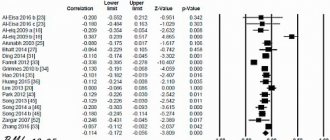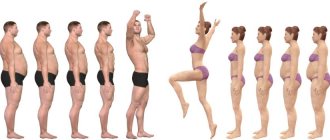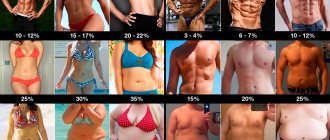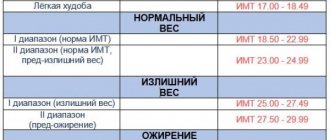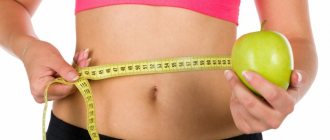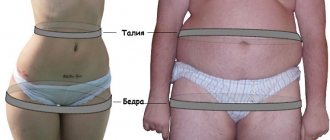How to calculate body mass index?
Body mass index (BMI) is a measurement used to measure obesity. Body mass index is a ratio of a person's height to weight.
To calculate your BMI:
- measure your height and convert it to meters.
- Square the resulting value. Suppose your height is 180 centimeters or 1.8 meters, which squared will be 1.8 * 1.8 = 3.24.
- divide your weight by this result. For example, with a weight of 90 kg, height is 180 cm. Accordingly, BMI = 90: (1.8 × 1.8) = 27.7.
The resulting number is your body mass index.
There are 6 groups based on body mass index:
- low weight - up to 18
- normal weight - from 18 to 25
- excess weight (pre-obesity) - from 25 to 30
- obesity 1st degree - from 30 to 35
- obesity 2nd degree - from 35 to 40
- obesity 3rd degree - from 40 and above
Tell me how to calculate the percentage of weight loss?
Table for determining activity level. Login to the site via social network:. By clicking the button, you agree to the privacy policy, user agreement, and receiving emails. Intake calculators Intake calculators calculate various daily norms - water, calories, proteins, carbohydrates, fats and determine metabolism. Calorie calculation A calculator to calculate the number of calories you should consume per day to achieve your desired weight.
Calculation of carbohydrates proteins fats Calculator for calculating in grams the amount of proteins, fats and carbohydrates that should be received per day.
How much water to drink Calculator to calculate the daily required amount of water in liters and glasses. Calculation of the amount of microelements Calculator for calculating the daily norm of microelements and vitamins.
Zigzag diet Calculator for calculating zigzag calories - the number of calories is different on different days, helps to shift weight. Calendar for losing weight or gaining weight Calendar for losing weight or gaining weight by day, indicating the planned weight for each day during the calorie diet. Basic metabolic rate Calculator for calculating the basic metabolic rate, that is, how many calories the body spends per day at rest.
Metabolic rate Calculator for calculating the actual metabolic rate, that is, how many calories the body burns daily, taking into account the load. Ideal weight calculation Calculates ideal weight for men and women using 20 formulas, notes the most famous formulas, also shows the ideal weight range according to the World Health Organization.
What should your body fat percentage be?
The amount of fat in the body is determined by weight, height and age, and also depends on gender. In turn, body type largely depends on the hereditary predisposition to obesity, past or chronic diseases, and metabolic rate. With age, the percentage of body fat increases. Women's fat content is slightly higher than men's. This is due to the production of the hormone estrogen, which affects fat metabolism.
The table shows the ideal fat content. Each person is individual, and therefore your indicators will probably differ from those presented below.
| Age | up to 30 | 30 – 50 | 50 and older |
| Women | 13 – 18% | 15 – 23% | 16 – 25% |
| Men | 6 – 14% | 11 – 17% | 12 – 19% |
Nutritionists believe that the normal percentage of fat is up to 31% in women and up to 25% in men. If your body fat index is much higher, consider diet and gym. Even if you have a predisposition to be overweight, you can lose weight if you change your habits: give up alcohol and smoking, even periodically, watch your diet, and exercise. The sooner you pay attention to your health, the higher quality of life you will ensure for yourself.
Weight loss calculator
Based on the data received and your desired weight, the calculator will calculate the number of calories you should consume per day to lose, gain or maintain weight. As a rule, calculations are made using several methods that will show an approximate range.
This is done to minimize the error of each individual calculation method. The calculation of the number of calories is shown in the “Weight loss” column.
If you reduce your calorie intake below the minimum, your body will begin to burn not only fat, but also muscle to obtain energy. The metabolic rate will drop and even a slight excess of calories will be stored by the body.
In addition, muscles consume several times more energy than fat cells. Therefore, burning muscles does not lead to positive results. The calculation results contain a table for calculating calories by day, the so-called “zigzag”.
User comments
It is believed that the best results are obtained if you vary your daily caloric intake slightly, maintaining an average value. A kilocalorie is a thousand calories.
One calorie is how much energy is required to heat 1 ml of water by 1 degree. But there is also a food or dietary calorie, which is equal to a kilocalorie. Product packaging may indicate the calorie content of products as either “kkak” or “cal”, and this will be referred to as kilocalories. Anna, office worker, two children. Does household chores when not at work. He goes in for sports three times a week. Height cm, weight 65 kg, age 35 years.
Wants to reduce weight to 57 kg. According to the Mifflin-San Jeor formula, the daily calorie consumption will be kcal, on average. To lose weight, Anna needs to reduce her daily caloric intake by about calories per day, that is, consume kcal. You can stick to the same number of calories per day, or you can move the calories to the previous or subsequent day from the day of training.
Also, if your weight suddenly reaches a weight plateau, then consuming calories according to the Zigzag pattern will help move it off the ground.
You can lose weight, but when you reduce your daily caloric intake, a person loses not only fat, but also muscle. Try to lead a more active lifestyle, do exercises, and add small physical activities. Recommended weight loss per week is no more than 1 kg.
A high rate of weight loss will lead to worse appearance, poor health, stress on the body, and fatigue. The ideal amount for increasing muscle mass is 1 kg per month for men and 0.5 kg per month for women. A large increase will lead to an increase not only in muscle, but also in fat. All calculations are based on mathematical and statistical formulas. But only a doctor can give an accurate assessment and recommendations.
Please consult your physician before starting a diet or changing your exercise level.
How to measure body fat percentage?
There are different methods for measuring body fat - from eyeballing to electrical impedance testing. Choose the appropriate method:
Measuring body fat percentage using an online calculator
There are many calculators on the Internet to calculate your body fat percentage. We recommend this body fat percentage calculator. Its design is outdated, but it is one of the most accurate online calculators. In the upper left corner is the calculator itself, on the right are detailed instructions.
Enter your data (height, weight, lifestyle) in the appropriate boxes and click “Calculate!” The resulting value will approximate your body fat content. The online calculator takes average values from existing databases, so this method has an error.
Measuring body fat percentage using the Lyle MacDonald formula
To measure body fat, you need to calculate the body mass index using the formula: Weight/Height2, where weight is body weight in kg, and height is height in meters.
For example: weight – 85 kg, height – 180 cm. According to the formula, body mass index is 85/1.8*1.8 = 26.2. Now compare your data with these indicators:
- with BMI = 13-20 body fat is 13.5-24%
- with BMI = 21-30 approximately 25.5-39% fat
- with BMI = 31-40 about 40.5-54% fat
As you can see, this method requires additional calculations and is not highly accurate.
Measuring body fat percentage by waist to hip ratio
Simple and fast method. Take a measuring tape and use it to measure your waist and hips. Divide your waist circumference by your hip circumference - the result should not exceed 0.8.
For example, waist circumference is 60 cm, hip circumference is 90 cm. Next: 60/90 = 0.67. This value is less than 0.8, which means everything is in order. If your result is more than 0.8, adjust your diet.
Measuring fat percentage using calipometry
Calipometry is a method of measuring skin folds on the abdomen. The measurement is made using a special device - a caliper, but you can also use a caliper or a regular ruler.
This is a simple and accurate method, the measurement error is only 3-4%. Stand up straight, take the caliper (or ruler) in your right hand. Pinch the skin and fat with the fingers of your left hand under the right nipple at the level of the navel. Measure the thickness of the resulting fold and compare the data with the tables below:
Measuring fat percentage on special scales
Many modern scale models measure your body fat percentage. The scales produce weak electrical impulses and measure the time it takes for the electrical signal to travel. Essentially, scales for calculating fat percentage measure the electrical conductivity of our tissues: muscles are excellent conductors, but fat has low electrical conductivity. The electrodes are installed directly in the scales. By stepping on the scale with your bare feet, you can find out your body mass index and body fat percentage.
A special device that works on the same principle, but through your hands, will also help you calculate the percentage of body fat. The device is taken in hands extended in front of you, an electrical impulse is passed through them, and the device counts the time it takes for the signal to pass through the tissue.
Attention!
Electrical impedance scales and devices are contraindicated for pregnant women and people with a pacemaker. Before using such scales, you should definitely consult your doctor!
Play sports, move and travel! If you find a mistake or want to discuss the article, write in the comments.
Subscribe to us on Telegram, YandexZen, VKontakte and Facebook
Weight loss calculator
Body mass index. Ideal weight. Useful literature. Table of calorie content of foods. Map of site. How many calories do you need to lose to lose weight? Weight Loss Calculator Calculate how long it will take to get down to your desired weight based on how many calories you don't take in each day.
Weight loss calculator. Set the slider to the desired position for your daily calorie deficit, the results will be calculated automatically by the calculator. Our counters. Start with the average, or a formula approximating the average.
If the results are not as effective as expected, try the following value: lower value for weight loss, higher value for bulking. Basal metabolic rate according to the Harris-Benedict formula is determined taking into account gender, age and body size.
The equation was first published in the year. The formula is suitable for men and women over 18 years of age. That is, as a result of the calculation, it may turn out that the need for calories is overestimated and a person begins to consume more calories than he actually needs. Due to shortcomings of the basic Harris-Benedict formula, an updated equation was published this year. Rosa and Schizgal conducted a study on a larger group, with data taken from Harris and Benedict's research papers.
Embed code without advertising with a direct link to the site. Embed code with advertising without a direct link to the site. Copy and paste this code onto your page where you want the calculator to appear. Calculator reference portal. Featured Services.
This formula already takes into account the features that in the old formula led to excess calories, and therefore this particular formula was more often used to determine the basal metabolism up to a year. Over time, people’s lifestyles change, new products appear, nutritional schedules and physical activity change. A new formula has been developed; it does not take into account the body's muscle mass, and is also calculated based on height, weight and age.
This equation is used in clinical settings to determine calories based on basal metabolic rate.
Weight calculator
According to research by the American Dietetic Association, the Mifflin-San Geor formula turned out to be the most accurate. In other sources it is considered. But this equation was only tested on Caucasian patients and therefore may not be accurate for other groups. The formula was not developed based on weight, but rather on lean muscle mass. Thus, this formula ignores energy aimed at maintaining fat and its accuracy for obese people is lower than for athletic people.
If you are in good physical shape, the result of this equation will be quite accurate for you. If you have just set out on the path to improving your figure, use the Mifflin-San Geor formula. The World Health Organization formula is based on the Schofield sex, age, weight and height formula currently in use.
Previously used in US dietary guidelines. Based on basal metabolic rate, thermic effect of food, physical activity and thermoregulation.
The formula is suitable for people over 20 years of age. Body surface area can be calculated based on your height and body weight. The answer is simple - in order to maintain, gain or lose weight, you need to know how many calories your body consumes. If you want to lose weight, you need to burn more calories than you consume. You only get calories if you eat or drink something. And you have to constantly spend calories - on the work of the body itself, on physical and mental stress. Women generally require calories to maintain weight.
For men, this value is greater - calories. Using an online calculator, you can calculate the calorie needs that you need for your existence, and calculate the number of calories for losing weight, gaining or maintaining weight. Calories are calculated based on weight, height, age and activity.
How to calculate percentages by dividing a number by 100
This will give you the numerical equivalent of 1%.
Then it all depends on your goal. To calculate the percentage of the amount, multiply it by 1%. To convert a number to a percentage, divide it by 1%. The Lifehacker Telegram channel contains only the best texts about technology, relationships, sports, cinema and much more. Subscribe!
Our Pinterest contains only the best texts about relationships, sports, cinema, health and much more. Subscribe!
Example 1
You go to the supermarket and see a promotion on coffee. Its regular price is 458 rubles, now there is a 7% discount. But you have a store card, and according to it, a pack will cost 417 rubles.
To understand which option is more profitable, you need to convert 7% into rubles.
Divide 458 by 100. To do this, you simply move the comma separating the integer part of the number from the fractional part two positions to the left. 1% is equal to 4.58 rubles.
Multiply 4.58 by 7 and you get 32.06 rubles.
Now all that remains is to subtract 32.06 rubles from the regular price. According to the promotion, coffee will cost 425.94 rubles. This means that it is more profitable to buy it with a card.
Example 2
You see that the game on Steam costs 1,000 rubles, although it was previously sold for 1,500 rubles. You are wondering what percentage the discount was.
Divide 1,500 by 100. Moving the decimal point two places to the left gives you 15. That's 1% of the old price.
Now divide the new price by 1%. 1,000 / 15 = 66.6666%.
100% – 66.6666% = 33.3333%. This discount was provided by the store.
How quickly you can lose weight or weight loss strategy
Real weight loss looks non-linear:
This is due to the fact that the body adapts to the changes that occur during the diet:
- Your weight decreases, which means you need less energy for basal metabolism (read more about the effect of energy balance on body weight);
- Since you eat less, the thermic effect of food (calories spent on digestion) decreases;
- Your expenses for training activity are reduced, because... the body weighs less and fewer calories are needed to carry out any work;
- It is possible that expenses for household needs will decrease - when there is little energy from food, we are less willing to do something, we get tired faster, etc.
To respond to the body's adaptation to the diet, correction of the deficiency is necessary. I talked about it in detail in this article. Read and implement.
But even with deficit correction, we need complete breaks during the diet:
- For psychological relief. By dividing your diet into small stages, you are less likely to lose control or give up the idea of losing weight altogether.
- To adapt the body to a new weight and diet. The biggest impact of a diet break is to reset the hormonal system (leptin, insulin, thyroid hormones and others), which constantly signals the brain to slow down the rate of fat burning.
A full break means we are on maintenance calories or ±10% of that number. The rest of the BJU numbers will remain the same as on a healthy diet (about 2 g of protein and 1 g of fat per 1 kg of weight and at least 100 g of carbohydrates per day).
The smoother the changes, the greater the chances of success and maintaining the results of the diet forever.
Marathons, crazy drying, and weight loss only work for a short time. You will get results from draining water from the body in case of extreme rates of weight loss (for example, before a competition or a significant event). For other cases, if a calorie-restricted diet is a burden to you, then after the end of the diet you will return to your usual diet, and as a result, the weight will return.
Therefore, we lose weight slowly, take breaks, consolidate the result, and at the same time build a diet that we can stick to constantly (all our lives) and feel comfortable . And if necessary, it is easy to adjust it to suit our goals (weight gain, maintenance or weight loss).
Again:
During a diet, you need to develop a diet that you can stick to for the rest of your life.
It is very difficult to lose weight and stay with the results if you adhere to a strict diet (unnecessary restrictions, exclusion of certain foods, etc.) and do not give your body a break.
In general, I have a wonderful article about nutrition - how to build a diet for weight loss without denying yourself anything.
Therefore, the weight loss strategy that Lyle McDonald suggests is to gradually reduce the percentage of fat by 5% in one cycle with a complete break in the diet for 4-8 weeks after that.
For example, we start losing weight with 30% body fat. We lost up to 25% of weight and took a complete break for 4-8 weeks. Then we lose weight to 20% fat and again take a break of 4-8 weeks. We start the next cycle with 20%, etc.
During a complete break, weight may increase and this is normal. The increase will mainly be due to an increase in carbohydrates in the diet - glycogen and water. They will easily move into the next cycle (two steps forward, one step back). It will be great if during this period the emphasis is on gaining muscle mass. This will also help you burn fat better in the future.
